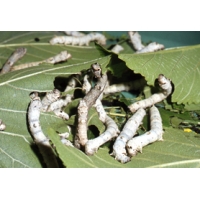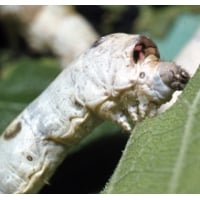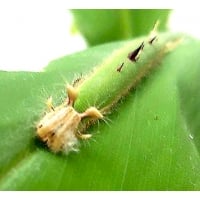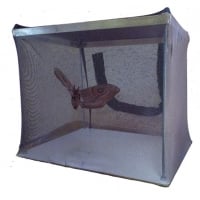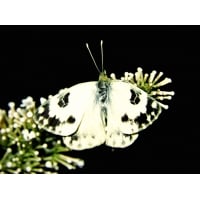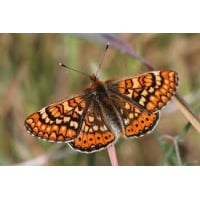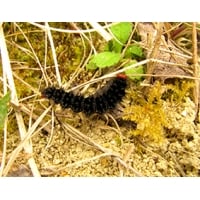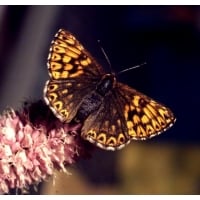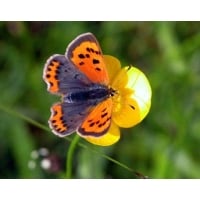Current EGGS and LARVAE
If you are a beginner and need information on rearing from small caterpillars, or hatching out pupae, please order the All Colour Paperback BUTTERFLIES. INSTRUCTIONS ARE NOT SENT WITH EACH SPECIES, you need to acquire basic skills and this book is a simple way of doing so.
SILKWORM EGGS Bombyx mori WHITE COCOONS
White larvae, producing attractive pure white cocoons. Silkworms require Mulberry leaf, or artificial diet.
Instructions are not sent with the eggs but they are given at the head of the Silk section. Click on silk near the bottom of the Main Menu (top left of the screen)
In winter orders will be booked for supply in the spring. The best rearing season is May to October. Eggs supplied from October onwards are for hatching in the following year. Although there are reports of using other foodplants, the only satisfactory food plant for silkworms is Mulberry. This is sometimes found in the gardens of large houses and old parsonages. Mulberry trees are available from larger nurseries. Any Morus species is suitable: White, Black or any other Mulberry. The larvae eat a lot, so make sure you have a good supply of leaves.
NOW YOU CAN REAR SILKWORMS EVEN IF YOU HAVE NO MULBERRY! There are sachets of artificial diet that you make up in the kitchen. Each sachet is the amount needed to rear 20 silkworms throughout their life.
SILKWORM EGGS Bombyx mori WHITE COCOONS
White larvae, producing attractive pure white cocoons. Silkworms require Mulberry leaf, or artificial diet.
Instructions are not sent with the eggs but they are given at the head of the Silk section. Click on silk near the bottom of the Main Menu (top left of the screen)
In winter orders will be booked for supply in the spring. The best rearing season is May to October. Eggs supplied from October onwards are for hatching in the following year. Although there are reports of using other foodplants, the only satisfactory food plant for silkworms is Mulberry. This is sometimes found in the gardens of large houses and old parsonages. Mulberry trees are available from larger nurseries. Any Morus species is suitable: White, Black or any other Mulberry. The larvae eat a lot, so make sure you have a good supply of leaves.
NOW YOU CAN REAR SILKWORMS EVEN IF YOU HAVE NO MULBERRY! There are sachets of artificial diet that you make up in the kitchen. Each sachet is the amount needed to rear 20 silkworms throughout their life.
All Colour Paperback BUTTERFLIES Robert Goodden.
No other book gives such plain and practical advice for the study of butterflies and moths.
A comprehensive guide - outlining techniques for the breeding and study of butterflies and moths. This book also shows a grand selection of butterflies of every continent. Packed with essential information, colourful pictures and diagrams by the butterfly artist JOYCE BEE. Paperback. 160 pages. 7 x 4". An essential guide for the beginner.
This book went out of print many years ago. WWB bought the entire stock of the English language edition. Stocks have now sold out. There are some used copies, damage or marking mainly on the covers, which does not materially affect the content. Even these are now down to rather few copies.
Published by Hamlyn. Available only from Worldwide Butterflies.
Caligo atreus Costa Rica
This is the finest of all the South American Owl butterflies. We have never offered livestock of this species before. Another FIRST.
The natural food is leaves of the Banana tree, but they have been recorded as accepting leaves of Canna, Calathea, Strelitzia and even Bamboo, but they may not always accept Bamboo, or thrive as well on it.
Pyjama Mini Cage 22 x 29 x 25cm high
This popular cage has just got even better. Nearly a third larger, and much improved dimensions.
Ideal as a beginner's cage, but also for the busy breeder who wants separate small cages. Excellent as an emerging cage for chrysalides and cocoons, ideal for keeping small numbers of larvae or other insects, when large enough for cage rearing.
This cage is suitable for laying out small numbers of pupae to emerge. Also for rearing smaller numbers of larvae or smaller larvae. Baby larvae should be first reared in plastic rearing containers or kept covered on growing food. Please see the note on the page for plastic rearing containers. This cage will hold small covered pots of plant, and larger sizes of cage are available for larger subjects.
When necessary the netting cover can be slipped off for cleaning or replacement. The Pyjama Mini cage is assembled in minutes and easily packed flat for winter storage. As the interest grows there are larger sizes available. For the experienced breeder the Mini Cage has many uses where a series of smaller cages is needed for separating species and giving different treatment.
The cover can be washed by hand or machine, making your used cage like new for almost no effort, and no cost.
Clouded Yellow Butterfly Colias crocea
This butterfly migrates and is not resident in Britain. Restrictions on travel have made it difficult to obtain sufficient breeding stock, so there is quite a waiting list. Adequate supplies in 2021 will depend on the ability to travel to obtain breeding stock.
A great favourite with entomologists and easy to rear on potted Clover. The easy way is to enclose the whole pot in a sleeve size 3. The larvae grow fast and will produce butterflies very quickly, particularly in warm conditions.
Bath White Pontia daplidice
Autumn Pupae may also become available.
The larvae feed on Mignonette, a flower of chalk soil, but they also feed on various Mustard family Cruciferae. Some people have done well rearing them on cauliflower - just let them loose on the raw heads!
This is a very rare migrant to Britain, found usually in the Mediterranean region. Baden Powel, a naturalist as well as pioneer, used the dappled pattern on the butterfy’s wings to disguise the plan of Mafeking when dispatched under siege!
Beckeri Marsh Fritillary Euodrydryas beckeri Now considered as a species separate from aurinia.
This is the most magnificent form of the Marsh Fritillary – very large, boldly marked and the brightest colouring and pattern of all. Beckeri occurs in parts of Spain, Portugal and North Africa. This stock is from Portugal. The larvae feed on Honeysuckle. In the wild these hibernate. It may be possible to keep summer larvae warm and with longer day length to get them to develop and produce butterflies again the same year. This has not yet been tried.
Glanville Fritillary Melitaea cinxia
EGG MASS, never offered before, is best attached to a large and healthy potted foodplant where the larvae can hatch, live in a web and eventually hibernate. We advise keeping the pot caged or sleeved, for protection from predators. An egg mass will produce dozens of larvae.
Feed on Narrow-leaved Plantain. Easiest to keep on potted foodplant, enclosed in a sleeve. The larvae are gregarious, living in a tight bunch at the base of the plant, and spreading out more as they grow larger. The ginger head capsule and jet black body distinguish these larvae from other species.
In Britain this species lives mainly on the Isle of Wight coast, but they have been established elsewhere in Britain. Maybe they could be encouraged in more localities.
Pearl-bordered Fritillary Clossiana euphrosyne
Becoming rather a scarce species. Very difficult to obtain.
Larvae best kept on a pot of violet enclosed in a sleeve or escape-proof cage.
Duke of Burgundy Fritillary Hamearis lucina
It is years since we have had Duke of Burgundy larvae. Now very hard to obtain.
Curious oval larvae like those of the Blues, but not green like those, more a straw colour, with rows of black dots. They live on Primrose or Polyanthus leaves.
Not difficult to rear on a potted plant. Resulting pupae have similar colouring and pattern. Store the pupae in a fridge until May when the delightful butterflies emerge.
Small Copper Butterfly Lycaena phlaeas
The larvae feed on common Dock and Sorrel. If kept warm they may pupate and produce butterflies before winter. In nature the larvae hibernate deep in plant litter. To hibernate the larvae, keep on a potted foodplant, completely enclosing plant and pot in a sleeve, and keep out of doors in all weathers.

